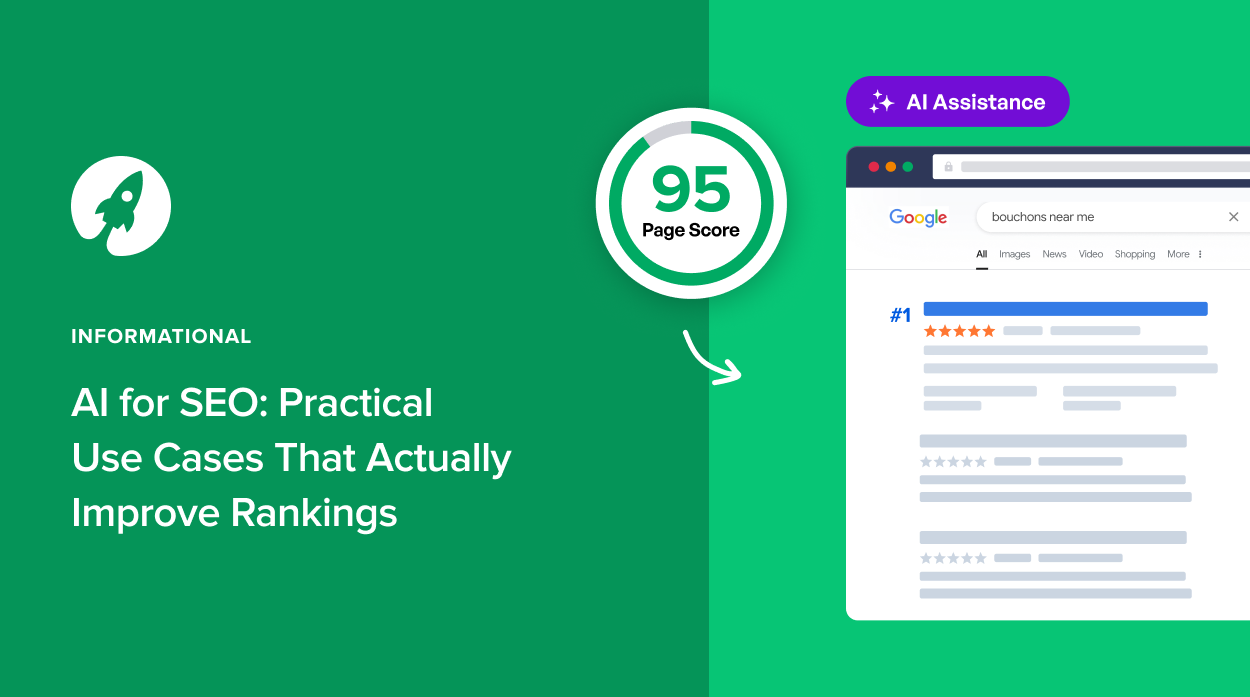Using AI for SEO is no longer a futuristic concept, but a practical, results-driven strategy that content marketers and SEO professionals are leveraging today.
From automating tedious keyword research to generating real-time optimization suggestions, AI is making SEO smarter, faster, and more scalable.
In this guide, I’ll walk you through 6 practical use cases of AI for SEO. Whether you’re managing content for a small blog or an enterprise-level website, these AI-powered SEO tools can unlock a new level of efficiency and performance.
Let’s start with a definition.
What Is AI for SEO?
AI for SEO refers to the application of artificial intelligence technologies, such as machine learning, natural language processing (NLP), and predictive analytics, to automate and enhance search engine optimization efforts.
Instead of manually analyzing keyword trends or reviewing on-page SEO performance, AI for SEO handles these tasks at scale, offering smarter suggestions and deeper insights based on real-time data.
The Role of AI in Modern SEO
There’s no escaping the truth now: AI is transforming how we optimize content and websites. It is changing the practices of traditional SEO by learning from data patterns and user behavior, allowing you to:
- Identify trends faster than competitors.
- Generate and optimize content at scale.
- Personalize search experiences for users.
- Continuously improve based on real-time insights.
In my experience working with AI SEO tools like SEOBoost, the productivity gains are immense.
I’ve cut keyword research time in half and consistently produced better-optimized content that actually ranks, without spending hours tweaking meta tags or manually scanning competitor sites.
How to Use AI for SEO?
So, let’s get into my playbook of how you can start using AI for SEO in your daily workflow.
1. AI-Powered Keyword Research
Keyword research lays the foundation for every successful SEO strategy. If you’re targeting the wrong keywords or missing out on high-opportunity ones, you’re essentially building your content on shaky ground.
Traditionally, this meant sifting through keyword lists, spreadsheets, and endless search volume charts. But with AI in the mix, the process becomes significantly more efficient.
AI tools analyze millions of data points in seconds, uncovering keyword opportunities based on search trends, competition, and search intent.
Instead of just showing you the obvious, AI tools can identify long-tail keywords, rising search terms, and semantic variations that people are searching for.
For example, LowFruits uses natural language processing to surface question-based keywords and low-volume opportunities that still bring real traffic.
This means you’re not just choosing keywords with high search volume, but keywords that make sense for your content, audience, and competition level.
2. AI for Content Creation and Optimization
You’ve probably heard it a thousand times: content is king. But with AI taking over, it’s not just about having content; it’s about having content that’s optimized for both humans and search engines.
That means you should create high-quality content that’s relevant, valuable, well-structured, and aligned with user intent.
This is where AI steps in and dramatically changes the game.
AI tools like SEOBoost’s Content Optimization feature analyze your content for any keyword and give you actionable suggestions to improve your content. These suggestions go beyond just sprinkling in keywords.
They help you:
- Match the content structure of top-ranking pages (e.g., number of headings, average word count).
- Optimize for readability by flagging long sentences and complex phrasing.
- Improve keyword usage without keyword stuffing.
- Include related topics or questions you should answer to improve content depth.
The real-time content editor highlights keyword gaps, offers heading suggestions, and flags readability issues as you write, so you’re never publishing blind.
AI content optimization ensures your post is built for performance from the start. It removes the guesswork from SEO writing and helps you craft content that’s comprehensive, clear, and search-engine ready, without spending hours manually comparing articles or running audits after publishing.
3. AI-Driven Content Personalization
Modern SEO isn’t just about ranking; it’s also about relevance.
Google’s algorithms increasingly reward websites that provide personalized, high-quality user experiences. That’s because personalized content leads to higher engagement, lower bounce rates, and more conversions, which are all strong signals for SEO.
AI tools leverage behavioral data, demographics, location, and search history to tailor content to each visitor.
Platforms like Dynamic Yield or PathFactory use AI to dynamically adjust what content a user sees based on their journey. These tools help teams align content with segmented keyword intent through their tailored content paths.
Here’s how AI-driven personalization works in practice:
- Dynamically serve different blog headlines or CTAs based on a user’s geolocation or referral source
- Present relevant case studies or product recommendations based on prior pages visited
- Adapt internal linking to match user behavior or content categories of interest
When users see content that speaks directly to their needs, they stay longer, click more, and are more likely to convert. This signals to Google that your content is satisfying keyword intent, which leads to better rankings over time.
4. AI for Technical SEO Audits
A website might have excellent content, but if it loads slowly, has broken links, or is hard for search engines to crawl, it won’t rank well. That’s where technical SEO comes in.
It’s the backbone that supports your entire SEO strategy. But manually auditing technical issues across dozens (or thousands) of pages is time-consuming. This is where AI shines.
AI-powered tools like All In One SEO and Screaming Frog automate technical SEO checks with greater depth and speed than manual audits.
They can identify issues like:
- Broken links and 404 errors
- Missing or duplicate meta tags
- Slow-loading pages and Core Web Vitals issues
- Non-indexable content or crawlability issues
- Unoptimized images and missing alt text
They often prioritize these issues by severity and suggest how to fix them, which saves even more time.
By identifying and resolving hidden technical issues early, you can enhance your website’s performance, improve the user experience, and send stronger quality signals to search engines.
5. AI for Predictive Analytics and Trend Forecasting
SEO isn’t just about reacting to what people are searching for today. It’s also about anticipating what they’ll be searching for tomorrow. That’s where predictive analytics comes in.
By forecasting trends before they peak, you can publish content early, build topical authority, and outrank your competitors when search volume spikes.
AI tools like BuzzSumo use large-scale data analysis to detect shifts in user behavior and rising keyword interest.
It analyzes historical search trends to uncover seasonal and evergreen content topics. It can also detect growing interest in niche or emerging topics across the web and social platforms.
With the forecast of future keyword performance based on current and past search data, you can base your strategy on what’s gaining traction in your industry.
This helps you dominate search results ahead of the curve, build topical authority, and steadily grow traffic with less effort.
6. AI for Backlink Analysis and Link Building
Backlinks continue to be one of the most important ranking signals for search engines. Quality links from authoritative websites signal trust, credibility, and relevance, which are all essential for climbing the SERPs.
But finding those opportunities and building a strategic link profile is time-consuming without AI.
AI-powered tools like Ahrefs streamline backlink discovery, analysis, and strategy by using machine learning to scan massive datasets and surface the most valuable insights.
It analyzes your backlink profile to identify strengths, weaknesses, and toxic links that could be hurting your rankings.
Based on competitor analysis and keyword targeting, it suggests high-authority websites likely to link to your content. You can also uncover where your competitors are getting their backlinks, and alert you when they gain or lose key links.
So, why is this important? Because manual backlink outreach is slow and often hit-or-miss.
AI eliminates the guesswork by helping you prioritize high-impact opportunities, target relevant domains, and refine your strategy based on what’s working, not just for you, but across your industry.
FAQs About AI for SEO
What is AI for SEO?
AI for SEO refers to the use of artificial intelligence technologies to automate, enhance, or streamline search engine optimization processes. It includes tasks like keyword research, content optimization, technical audits, backlink analysis, and predictive forecasting.
Can AI be used for SEO?
Yes, AI is increasingly being used for SEO. It enhances efficiency, accuracy, and decision-making by analyzing large datasets, identifying trends, and providing actionable recommendations more quickly than manual methods.
Which AI is best for SEO?
The best AI tool for SEO depends on your needs. For content optimization and planning, SEOBoost offers real-time suggestions and Topic Reports. For backlink analysis, Ahrefs is highly effective.
Final Word
From uncovering smarter keywords to optimizing content in real time and scaling backlink strategies, AI for SEO transforms how we approach optimization and content practices.
The key is not just to adopt AI tools, but to use them thoughtfully.
Start by integrating one or two solutions, such as SEOBoost for content or Ahrefs for backlinks, and gradually build a tech stack that complements your goals.
With the right tools and strategy, AI can do more than assist your SEO efforts — it can amplify their results.




